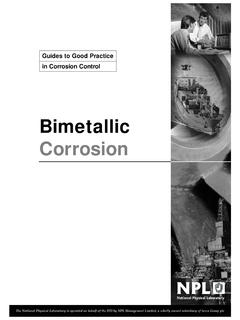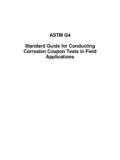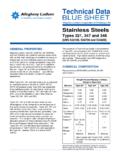Transcription of Micro Motion Corrosion Guide - Emerson
1 Micro Motion Corrosion GuideFor Coriolis Flow and Density Meters, Density Meters, andViscosity MetersH2SO4 HClNaOHHNO3C6H8O7CH4Cl2H3PO4C3H8 OGI-00415, Rev HJanuary 2014 Disclaimer: The guidelines in this publication are provided for informational purposes changes in fluid properties ( , temperature, concentration, impurity levels) can affectthe compatibility of wetted parts. Material compatibility choices are solely the responsibility ofthe end user. 2014 Micro Motion , Inc. All rights Emerson logo is a trademark and service mark of Emerson Electric Co. Micro Motion , ELITE, ProLink, MVD and MVD Direct Connect are marks of one of the Emerson Process Management family of companies. All other trademarks are property of their respective Motion Corrosion Guide1 ContentsCoriolis flow and density for mixed materialbi-metallic meter to use the materialcompatibility table for Coriolis compatibility table forCoriolis and viscosity to use the materialcompatibility table for Density and compatibility table fortube density compatibility table forfork density meters, viscosity flow and density metersCoriolis mass flow and density meters are a majoradvance in flow measurement.
2 These deviceshave set a precedent for accuracy andrepeatability under a wide variety of flowconditions. The inherent precision has establishedit as a standard for numerous industrialapplications. The ability of these meters tomeasure mass flow and density directly has led totheir use in applications ranging from meteringfood products to corrosive chemicals. Coriolismeters have proven extremely reliable whenmetering noncorrosive fluids. The same reliabilitycan be achieved in corrosive services ifconsideration is given to the compatibility of theprocess fluid with the sensor materials satisfy the need of selecting the right materialfor a given application, Micro Motion manufacturesmeters in 316L, 304L, and super duplex stainlesssteels, 316L stainless steel lined with Tefzel coating, nickel alloy C22, titanium, and compatibilityMaterial compatibility must be considered in moredetail for Coriolis meters as compared topressure-containing pipe.
3 Compatibility in thelatter case is usually addressed by consulting ageneral Corrosion Guide . General Corrosion is aterm that refers to the uniform loss of rate of material removal is usually expressedin terms of inches or millimeters lost per rates are determined experimentally byexposing a sample to the environment for aspecific time period. Weight loss or dimensionalchanges are then used to determine the Corrosion tests are insensitive todetection of localized Corrosion and are notalways adequate for determining materialcompatibility for Coriolis meters. Pitting,intergranular attack, stress Corrosion cracking,and Corrosion fatigue are all forms of localizedcorrosion that can lead to meter Corrosion of the flow tube can initiatefatigue cracking. Meter failure can then occur dueto the rapid rate at which fatigue crackspropagate.
4 The approach to preventing meterfailure is to avoid the onset of fatigue cracks. Forthis reason, the possibility of localized corrosiveattack must be considered when selecting Motion Corrosion GuideCoriolis flow and density meterscontinuedMaterial compatibility cannot always be assessedby considering the alloy(s) selected for theremainder of the piping system. Materialcompatibility for most piping systems is basedupon general Corrosion rates alone and does notaccount for localized Corrosion or cyclic meters require vibration of one or two flowtubes to make a mass flow or densitymeasurement. The cyclic loading condition isinherent to all Coriolis meters and must beconsidered in the material selection compatibility variablesThe numerous environments in which the metercan be used make it difficult to define process fluidcompatibility for every possible materialcombination.
5 The difference in chemicalcomposition of most environments can becharacterized by four variables. These arehalogen concentration, pH, chemical potential,and temperature. If these variables can be definedfor a particular environment, comparisons of alloylimitations can be made and a compatible materialof construction chosen. Figures 1 through 4 showthe domain of acceptable performance for 316 Lstainless steel, nickel alloy C22, titanium, andtantalum as a function of the first three effect of temperature on meter life can becharacterized by considering its effect on the otherthree termhalogenrefers to a specific group ofelements and includes chlorine, fluorine, bromine,and iodine. The most common halogen ischlorine. The presence of the ionic form, Cl , evenas a contaminant, can be extremely detrimental tocorrosion resistance.
6 Stainless steels areparticularly susceptible. Meters constructed of316L stainless steel have been extremely reliablein numerous applications where chlorideconcentrations can be maintained at sufficientlylow levels or where free chlorides are absent (seeFigure 1). Stainless steel can also be used inorganic solutions that contain a chloridecomponent, provided ion formation is factors that influence dissociation aretemperature and moisture. Both need to be keptlow to avoid failure. Figure 2 shows that theresistance of 316L to free chloride-inducedcorrosion fatigue is temperature dependent. Lowcombinations of temperature and chlorideconcentration are compatible with 316L stainlesssteel. Pitting and Corrosion fatigue are possible forhigher combinations of temperature and chlorideconcentrations.
7 Nickel alloy C22 should be usedwhen these conditions exist. If the chloridecontent is increased further and pH lowered,nickel alloy C22 may also succumb to localizedattack and Corrosion pH of a solution can also alter the corrosionbehavior of any given alloy. In general, solutionsthat have a neutral pH (near 7) tend to be lessaggressive than strongly acidic (pH < 3) orstrongly alkaline (pH > 11) solutions (seeFigure 3). Tantalum, for example, has superiorcorrosion resistance to 316L stainless steel andnickel alloy C22 in neutral and acidicenvironments. However, high Corrosion rates willoccur if tantalum is used in caustic applicationssuch as sodium hydroxide, even at roomtemperature. At higher temperatures, stresscorrosion cracking and Corrosion fatigue arepossible. Under these conditions, nickel alloy C22is recommended.
8 Nickel alloy C22 should be usedin all caustic applications in which there is apossibility of chloride Motion Corrosion Guide3 Coriolis flow and density meterscontinuedChemical potentialThe chemical potential is a measure of theoxidizing or reducing power of a process potential, sometimes referred to asredoxpotential, is defined relative to theH2 2H++2e half reaction, which is assigned avalue of zero volts. Any environment that has achemical potential greater than the reference isconsidered oxidizing. Chemical potentials that areequal to or less than the reference are consideredreducing. Chemical potential is important becausea minimum amount of oxidizing power is requiredto enable the formation of protective surface oxidelayers. Optimal life will be realized as long as thislayer is stable.
9 Environments that are too oxidizingor reducing will prevent stable oxide such conditions, failure due to corrosionfatigue or erosion/ Corrosion is Corrosion fatigue resistance of a material ofconstruction is related to the range of chemicalpotentials over which oxide layer stability ismaintained. The broader the range in Figure 4,the more environments in which the material willresist pentoxide (Ta2O5) is stable on thesurface of metallic tantalum at extremely lowreducing potentials. This oxide also resistsbreakdown in all but the most wide range of chemical potentials over whichpassivity is maintained make tantalum resistant tomost corrosive fluids. The second most stableoxide forms on the surface of nickel-based alloyssuch as nickel alloy C22. A high chromium andmolybdenum content stabilizes the oxide layer,yielding improved performance over 316 Lstainless steel in chloride bearing stainless steel exhibits passivity over anarrow range, as compared to the other twomaterials.
10 However, 316L stainless steel hasproven to be suitable for a large number ofchemical processing Motion Corrosion GuideFigure 1. Typical chloride concentrationrange for meter materialsFigure 2. Chloride ion concentrations andtemperature limits for 316 LFigure 3. Typical pH range for metermaterialFigure 4. Chemical potential range for metermaterialsSSC22 Titanium Tantalum316L unacceptableUse high-nickel-based alloyUse 316 Lstainless steel02001601208040 Chloride (ppm)2030405060 Temp. CHighLowSSC22 Titanium TantalumReducingOxidizingSSC22 Titanium TantalumHighLowNeutralMicro Motion Corrosion Guide5 Coriolis flow and density meterscontinuedTefzel Experience suggests that some applications areaggressive to all metallic components. Processfluids containing fluorine will rapidly corrode anymetal.
















